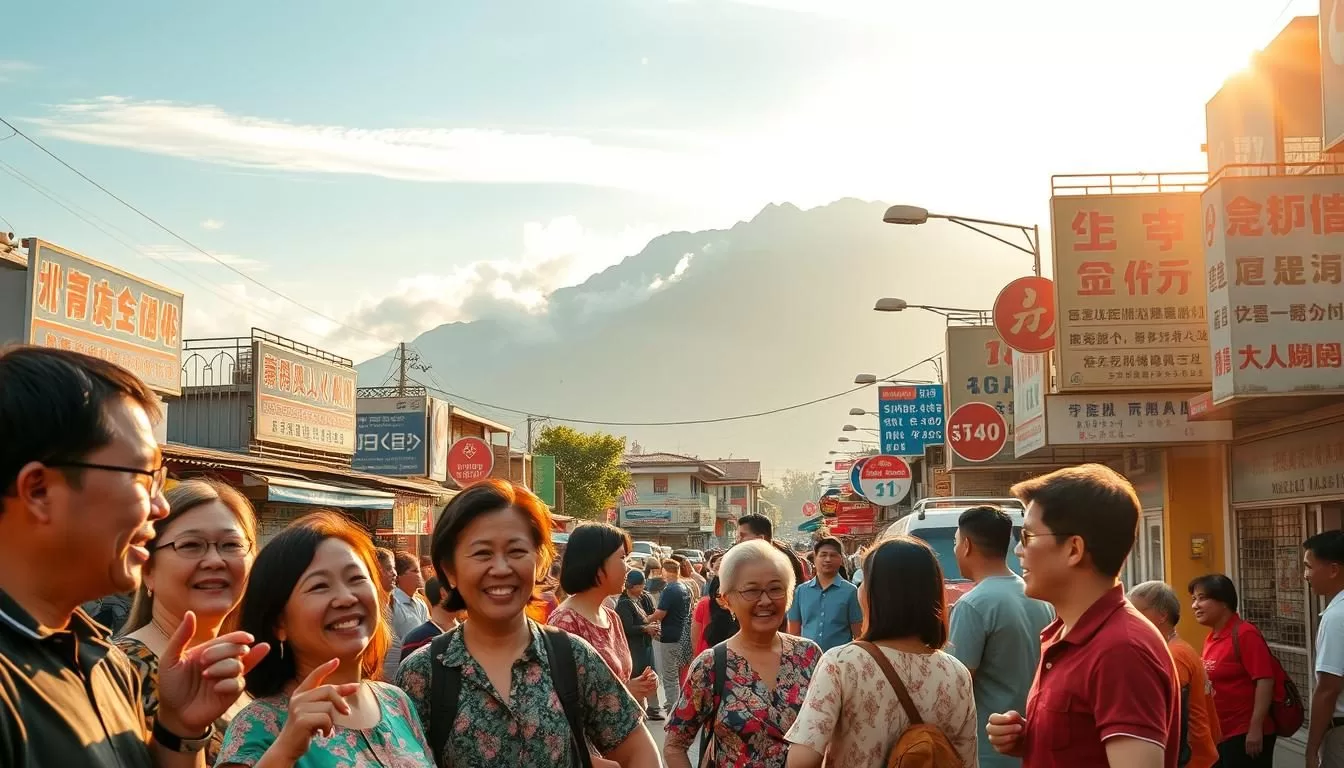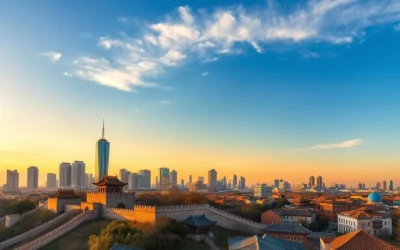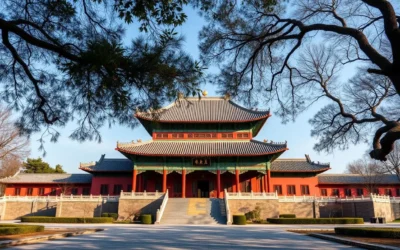✓ Accommodations✓ Flights✓ Rental Cars
Nestled in the southernmost part of its region, this island is a melting pot of cultures and languages. Its geographic location has shaped a vibrant mix of dialects and speech patterns, influenced by centuries of history. From the coastal plains to the mountainous interior, the area boasts a fascinating linguistic heritage.
You’ll discover how historical events and trade routes have left their mark on the way people communicate here. The island’s unique position has fostered a blend of influences, creating a rich cultural backdrop. This diversity is reflected in the everyday speech of its inhabitants.
With a population of over 10 million, the province is home to a variety of ethnic groups, each contributing to its linguistic landscape. Understanding this foundation sets the stage for a deeper exploration of its culture and traditions. Dive in to uncover the stories behind the words spoken here.
Introduction to Hainan’s Linguistic Heritage
Diverse ethnic groups have shaped the unique language landscape of this region. Over centuries, historical migrations and cultural exchanges have created a rich tapestry of dialects and speech patterns. This linguistic diversity is a living testament to the island’s vibrant past and its connections to the broader world.
Different groups have contributed to this cultural mosaic, each bringing their own traditions and languages. From indigenous communities to settlers from neighboring regions, their influence is evident in everyday communication. This blend of voices highlights the island’s role as a crossroads of cultures.
In a global context, the development of languages here mirrors trends seen around the world. Modern initiatives, such as educational programs, play a key role in preserving these linguistic treasures. These efforts ensure that the island’s heritage continues to thrive in a rapidly changing world.
Understanding this linguistic heritage offers a glimpse into the island’s cultural and historical evolution. It’s a story of resilience, adaptation, and the enduring power of language to connect groups across time and space.
Geography and Historical Background of Hainan
Shaped by tectonic shifts and environmental forces, this region’s landscape tells a tale of resilience. Its ancient land formation, once connected to the mainland, was separated by geological activity, creating a unique island environment. This separation has influenced the distribution of its dialects, with natural barriers encouraging linguistic diversity over time.

Key geographic landmarks, such as Wuzhi Mountain, the island’s highest point at 1,876 meters, and the expansive coastal plains, have played a significant role in shaping settlement patterns. These features not only define the physical landscape but also impact the way local dialects have evolved. For example, the mountainous terrain has historically isolated communities, fostering distinct speech patterns.
Land Formation and Key Geographic Features
The island’s geography is marked by its central highlands and surrounding lowlands. Wuzhi Mountain stands as a prominent feature, while rivers like the Nandu and Wanquan flow through the region, supporting agriculture and settlement. These natural elements have influenced the development of the chinese language here, with each area contributing its own linguistic nuances.
Climate and Environmental Influences
The tropical climate, with annual rainfall ranging from 900 to 2400 mm, has shaped both the environment and human activity. The fertile plains support crops like rice and sugarcane, while the coastal areas are hubs for trade and communication. This interplay of climate and geography has not only determined settlement patterns but also enriched the island’s linguistic heritage.
Understanding the island’s geography and history provides valuable insights into its cultural and linguistic evolution. From its ancient land formation to its modern-day climate, every aspect of the environment has left a lasting mark on the way people communicate here.
Imperial Influence and Historical Migrations
From dynastic exiles to coastal settlers, the island’s language diversity has deep historical roots. Imperial policies played a significant part in shaping migration patterns, which in turn influenced local dialects. Over centuries, the region became a melting pot of cultures, blending indigenous traditions with external influences.
Dynastic Exiles and Sinicization
During the Han dynasty, exiled officials and scholars brought their language and customs to the island. This process, known as sinicization, was enforced by the government to integrate the region into the broader empire. Figures like Su Shi, a renowned poet, left a lasting impact through their writings, reflecting their experiences in exile.
These exiles not only introduced new vocabulary but also influenced the way local communities communicated. Their presence helped bridge cultural gaps, creating a unique blend of speech patterns. This historical context is still evident in the island’s linguistic landscape today.
Migrations from Guangdong and Fujian
Migrations from coastal regions like Guangdong and Fujian further enriched the island’s dialects. Settlers brought distinct speech patterns, which merged with local languages to form new variants. These migrations were driven by economic opportunities and government policies encouraging resettlement.
Today, the influence of these migrations can be heard in the way speakers across the island communicate. The blending of dialects from different regions highlights the island’s role as a cultural crossroads. Understanding this history offers insight into the evolution of its linguistic identity.
Hainan Province, China: Official and widely spoken languages
Language policies play a crucial role in shaping communication and cultural identity. In this region, government initiatives have been implemented to standardize speech while preserving local dialects. These efforts aim to create a unified system that respects diversity.
One key focus is on education. Schools now prioritize teaching Mandarin, the official language, to ensure consistency across the region. This approach helps students access broader opportunities while maintaining their cultural roots.
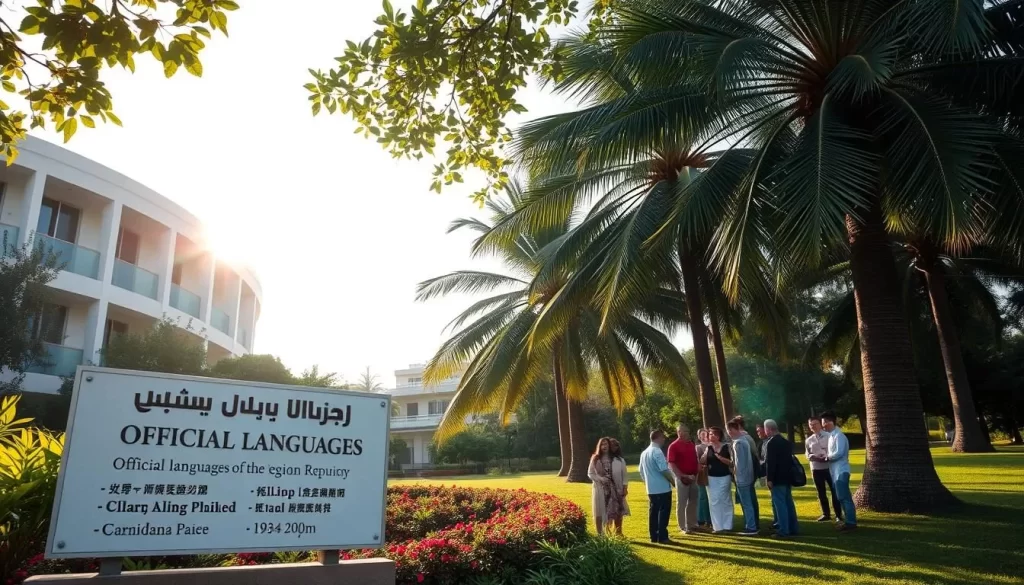
Public services also reflect these policies. Government offices and healthcare facilities use Mandarin as the primary language for efficiency. However, local dialects are still supported in community settings, ensuring inclusivity for all residents.
Different areas within the region adapt these mandates to fit their unique needs. For example, urban centers may emphasize Mandarin more heavily, while rural areas balance it with local speech patterns. This flexibility helps maintain cultural identity while fostering unity.
The impact of these policies is evident in everyday life. From classrooms to workplaces, the system ensures clear communication while celebrating linguistic diversity. This balance is key to the region’s cultural and social harmony.
Balancing Standardization and Preservation
Government policies aim to strike a balance between standardization and preservation. While Mandarin is promoted for national cohesion, local dialects are encouraged in community events and cultural activities. This dual approach supports both progress and tradition.
For instance, festivals often feature performances in local dialects, showcasing the region’s rich heritage. At the same time, official documents and media use Mandarin to ensure clarity and accessibility.
| Policy Focus | Impact |
|---|---|
| Education | Mandarin taught in schools, local dialects preserved in cultural programs. |
| Public Services | Mandarin used for efficiency, dialects supported in community settings. |
| Regional Adaptation | Urban centers emphasize Mandarin, rural areas balance with local speech. |
This balanced system ensures that the region’s linguistic heritage thrives while adapting to modern needs. It’s a testament to the power of thoughtful policy in shaping cultural identity.
Standard Mandarin’s Role in Hainan
Standard Mandarin bridges communication gaps across diverse communities. With over 1.2 billion speakers globally, it serves as a unifying force for a vast population. In this region, it plays a central role in education, government, and daily life.
Mandarin’s adoption ensures clear communication in schools and public offices. It’s the primary language taught in classrooms, helping students access broader opportunities. This approach fosters national unity while respecting local traditions.
Mandarin in Education and Government Sectors
In schools, Mandarin is the cornerstone of the curriculum. Teachers emphasize its importance to prepare students for a connected country. This focus ensures that every person can communicate effectively, regardless of their background.
Government offices also rely on Mandarin for efficiency. From healthcare to public services, it’s the language of choice. This standardization streamlines processes and ensures accessibility for all residents.
| Sector | Role of Mandarin |
|---|---|
| Education | Primary language taught in schools, fostering national unity. |
| Government | Used in public services for clear and efficient communication. |
| Daily Life | Serves as a bridge language for diverse communities. |
Mandarin’s role extends beyond formal settings. It connects people from varied cultural backgrounds, making it a vital tool for modern society. This standardized approach is crucial for a country with such a diverse population.
Regional Dialects: Hainanese, Cantonese, and Min Variants
The linguistic tapestry of this region is woven with threads of history, migration, and cultural exchange. Regional dialects like Hainanese, Cantonese, and Min variants are a living legacy of these influences. Each dialect carries unique characteristics, shaped by centuries of interaction and adaptation.
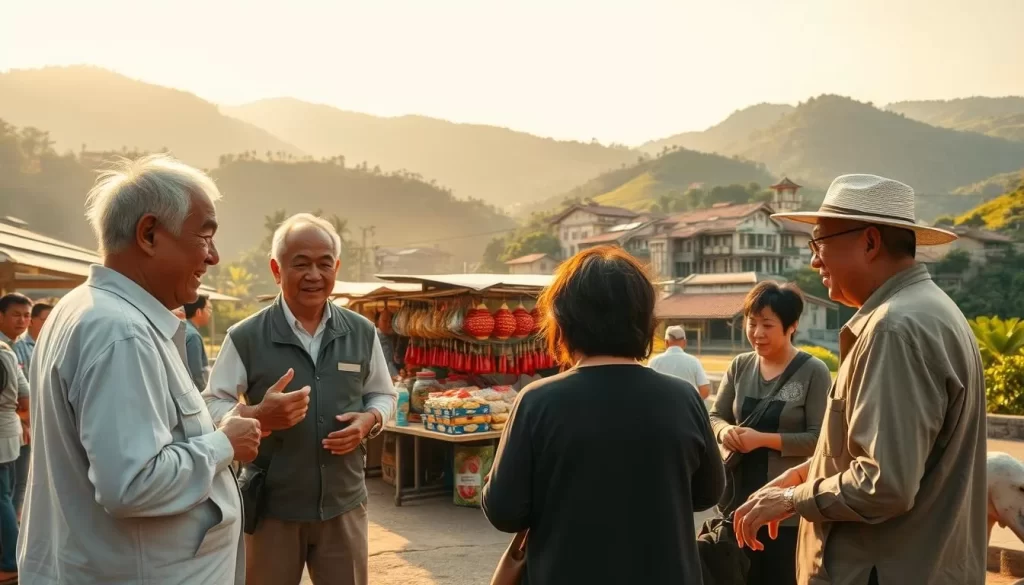
Characteristics of the Hainanese Dialect
The Hainanese dialect stands out for its distinct phonetic features and vocabulary. It reflects the island’s isolation and its historical connections to neighboring regions. For example, its tonal system differs significantly from Mandarin, making it a fascinating study in linguistic variety.
Over time, this dialect has evolved to meet modern communication needs. It’s now used in various service sectors, from tourism to local businesses. This adaptability ensures its continued relevance in a changing world.
Influences from Cantonese and Southern Min
Cantonese and Southern Min have left a lasting mark on the region’s dialects. These influences are evident in shared vocabulary and grammatical structures. For instance, many words in Hainanese trace their roots to Southern Min, highlighting the deep cultural connections.
These dialects also reflect the region’s role as a crossroads of trade and migration. Over time, they’ve blended with local speech patterns, creating a rich linguistic mosaic. This variety is a testament to the region’s dynamic history.
- Hainanese: Known for its unique tones and vocabulary.
- Cantonese: Contributes shared words and phrases.
- Southern Min: Influences grammar and pronunciation.
These dialects are not static; they continue to evolve with modern service demands. From education to media, they adapt to new contexts while preserving their cultural roots. This balance ensures their survival in a globalized world.
The Role of Minority Languages and Ethnic Communities
The cultural richness of this region is deeply rooted in its minority languages and ethnic communities. These groups, such as the Li and Hlai, play a vital role in preserving unique traditions and speech patterns. Despite the influence of dominant languages from the mainland, their efforts ensure that these languages thrive.
You’ll find that a significant number of ethnic communities actively safeguard their native tongues. This dedication helps maintain cultural identity and fosters a sense of belonging. Their practices often trace back to ancient origins, offering a glimpse into the region’s history.
The Li, Hlai, and Other Indigenous Languages
The Li and Hlai languages are prime examples of this linguistic diversity. These indigenous languages are not just means of communication but also carriers of cultural heritage. They reflect the region’s unique identity, distinct from the mainland influences.
Efforts to preserve these languages are ongoing. Community-led initiatives and educational programs ensure that younger generations learn and value their ancestral speech. This approach highlights the role of language in sustaining traditions.
Understanding these minority languages enriches the region’s overall cultural heritage. They serve as a bridge between the past and the present, offering insights into the lives of those who came before. This connection is vital for maintaining a diverse and vibrant society.
Linguistic Evolution Amid Trade and Globalization
Over the past century, trade and globalization have reshaped the way people communicate in this region. Historical trade routes, especially those connecting to southern china, have left a lasting impact on the dialects spoken today. These routes facilitated cultural exchange, blending local speech patterns with external influences.

You’ll notice that the evolution of linguistic characteristics stems from interactions beyond southern china. For example, the introduction of new vocabulary and grammar reflects the region’s role as a cultural crossroads. This blending of dialects highlights the dynamic nature of language as a living facet of modern identity.
Globalization challenges traditional language practices while opening new avenues for evolution. The rise of digital communication and international trade has accelerated these changes. This shift is part of broader economic and cultural trends shaping the way dialects are spoken.
Understanding this evolution offers insight into the region’s adaptability. From historical trade routes to modern globalization, language continues to evolve. This adaptability ensures its relevance in a rapidly changing world.
| Factor | Impact on Language |
|---|---|
| Trade Routes | Introduced new vocabulary and blended dialects. |
| Globalization | Accelerated changes in speech patterns. |
| Cultural Exchange | Enriched linguistic diversity. |
To learn more about how globalization influences cultural trends, explore this detailed analysis. The interplay of trade, culture, and language reveals the region’s unique identity in a globalized world.
Cultural Impacts of Language Diversity
The vibrant culture of this region is deeply intertwined with its linguistic diversity, shaping art, traditions, and community bonds. The min language plays a pivotal role in enriching local art forms and cultural expressions. From traditional performances to oral storytelling, it serves as a vital resource for preserving cultural memory.
Natural elements, like the rugged mountain landscapes, inspire creative expression. These settings often feature in folklore and artistic works, reflecting the region’s deep connection to its environment. Stories passed down through generations highlight the interplay between language and art, defining key elements of social identity.
Traditional Arts and Oral Storytelling
Traditional arts and oral storytelling are more than just entertainment; they are a bridge to the past. The min language breathes life into these practices, ensuring that cultural heritage remains alive. Performances often include songs, dances, and narratives that reflect the region’s history and values.
These cultural forms are vital for maintaining community bonds. Festivals and gatherings provide opportunities for people to connect, share stories, and celebrate their shared identity. The resource of oral storytelling ensures that knowledge and traditions are passed down to future generations.
“Language is the road map of a culture. It tells you where its people come from and where they are going.”
The influence of the mountain landscapes is evident in many artistic works. Artists and storytellers draw inspiration from the natural beauty, creating pieces that resonate with the community. This connection between nature and culture is a defining feature of the region’s identity.
| Cultural Form | Role of Language |
|---|---|
| Traditional Arts | Preserves history and values through performances. |
| Oral Storytelling | Passes down knowledge and strengthens community bonds. |
| Inspiration from Nature | Mountain landscapes influence artistic expression. |
To explore more about the linguistic diversity of this region, visit this detailed analysis. The interplay between language, art, and nature offers a unique glimpse into the cultural richness of the area.
Education and Language Policies in Modern Hainan
Education plays a pivotal role in shaping the linguistic future of this tropical region. Schools here are designed to balance tradition with innovation, ensuring that both official and local dialects thrive. The region’s rivers of history flow through its classrooms, enriching language learning and cultural continuity.
Curriculum Development in Schools
Modern curricula in this region emphasize bilingual education, integrating local dialects alongside Mandarin. Approximately 15% of schools offer instruction in minority languages, reflecting a commitment to cultural preservation. This approach ensures that students are well-prepared for global opportunities while staying connected to their roots.
Collaborations between schools and local cultural organizations further enrich the learning experience. These partnerships provide students with immersive opportunities to explore their heritage. For example, festivals and storytelling events often feature prominently in the academic calendar.
Government Initiatives for Language Preservation
The government has implemented rigorous policies to support language preservation. Around 5% of the education budget is allocated specifically for minority language initiatives. This funding supports teacher training, resource development, and community programs.
Efforts to preserve local dialects are driven by both policy and community needs. For instance, the number of minority language publications has increased by 30% over the last decade. This growth highlights a growing interest in safeguarding linguistic diversity.
| Initiative | Impact |
|---|---|
| Bilingual Education | 15% of schools offer instruction in minority languages. |
| Funding Allocation | 5% of the education budget supports minority language programs. |
| Community Partnerships | Collaborations with cultural organizations enrich learning. |
These initiatives ensure that the region’s linguistic heritage remains vibrant. By balancing tradition with innovation, schools here are shaping a future where cultural identity thrives alongside modern progress.
Technology, Translation, and Digital Language Resources
Technology is reshaping how people communicate and preserve linguistic heritage in this tropical region. Modern tools are bridging gaps, making it easier to learn and use the language spoken here. These innovations are transforming education, business, and daily life.
Digital language resources are playing a key role in this transformation. From translation apps to online platforms, these tools help people connect across dialects and cultures. They also support the preservation of minority languages, ensuring they remain relevant in a digital age.
Modern Tools Bridging Communication Gaps
Innovative translation tools are making it easier to learn and use the official language and local dialects. For example, AI-powered platforms can translate text and speech in real-time. These tools are especially useful for tourists and businesses on the island.
Educational systems are also integrating technology to enhance language learning. Schools now use apps and online resources to teach both Mandarin and local dialects. This approach ensures students are prepared for global opportunities while staying connected to their roots.
- Translation Apps: Real-time tools for seamless communication.
- Online Platforms: Resources for learning and preserving dialects.
- AI Technology: Enhances accuracy and efficiency in translation.
These digital efforts benefit both local communities and the broader island network. They ensure that linguistic diversity thrives in a globalized world. For more on how technology supports language preservation, explore Hainanese language services.
Comparing Hainan’s Linguistic Landscape to Broader China
The linguistic diversity of this tropical region offers a unique contrast to broader mainland areas. While major cities like Beijing and Shanghai emphasize Mandarin, this region blends local dialects with broader influences. This mix creates a vibrant linguistic environment that stands out nationally.
In urban centers, Mandarin dominates due to its role as the official language. However, this region retains a strong connection to its local dialects. These dialects are shaped by centuries of immigration and cultural exchange, making them distinct from those in other areas.
Translation challenges often arise when interfacing with international communities. For example, local dialects can differ significantly from standard Mandarin, complicating communication with visitors from the united states or other countries. These challenges highlight the region’s unique linguistic identity.
Local traditions play a key role in shaping these dialects. Festivals and community events often feature performances in native speech, preserving cultural heritage. This contrasts with urban centers, where such traditions are less prominent.
| Region | Primary Language | Unique Features |
|---|---|---|
| This Region | Local Dialects | Blend of indigenous and external influences |
| Major Cities | Mandarin | Standardized communication |
Understanding these differences helps appreciate the region’s cultural spirit. Its linguistic landscape reflects a rich history and a commitment to preserving diversity. For more insights, explore this detailed analysis.
Future Prospects and Economic Impact on Language Services
The transformation of this region into a free trade port is reshaping its linguistic and economic landscape. Strategic trade policies are driving growth, creating new opportunities for language resource expansion. You’ll see how these changes are influencing local language practices and services.
Tourism and the Free Trade Port Strategy
Tourism plays a key role in this transformation. With the region becoming a hub for international visitors, there’s a growing demand for translation and interpretation services. This shift is boosting the chinese variety of language offerings, ensuring visitors and locals can communicate effectively.
Integration with mainland china’s trade dynamics is also benefiting local language practices. As trade increases, so does the need for multilingual professionals. This trend is opening doors for those skilled in both Mandarin and regional dialects like the min dialect.
Economic Development and Language Resource Expansion
Economic development plans are closely linked to the growth of language services. As businesses expand, they require skilled translators and interpreters to navigate global markets. This demand is driving investment in language education and resources.
Educational institutions are adapting to these changes. Programs now focus on bilingual and trilingual skills, preparing students for careers in translation and international business. This approach ensures the region remains competitive in a globalized economy.
| Initiative | Impact |
|---|---|
| Tourism Growth | Increased demand for translation services. |
| Trade Integration | Boosted need for multilingual professionals. |
| Educational Programs | Enhanced focus on bilingual and trilingual skills. |
These initiatives bring both challenges and opportunities. While they promote economic growth, they also require careful planning to preserve linguistic diversity. Balancing progress with tradition is key to the region’s future success.
Conclusion
The linguistic journey of this region reflects a rich blend of history and modernity. From the influence of past dynasties to the preservation of southern min traditions, every effort contributes to cultural conservation. Schools, communities, and government initiatives work together to maintain this heritage.
You’ll find that preserving language dialects is more than a cultural act—it’s a bridge to the past. These dialects carry stories of migration, trade, and adaptation. They remind us of the value of diversity in shaping identity.
Modern challenges require innovative solutions. Technology and education play key roles in keeping these dialects alive. By valuing this linguistic legacy, you support a future where tradition and progress coexist. Explore more about this fascinating topic here.
The above is subject to change.
Check back often to TRAVEL.COM for the latest travel tips and deals.
